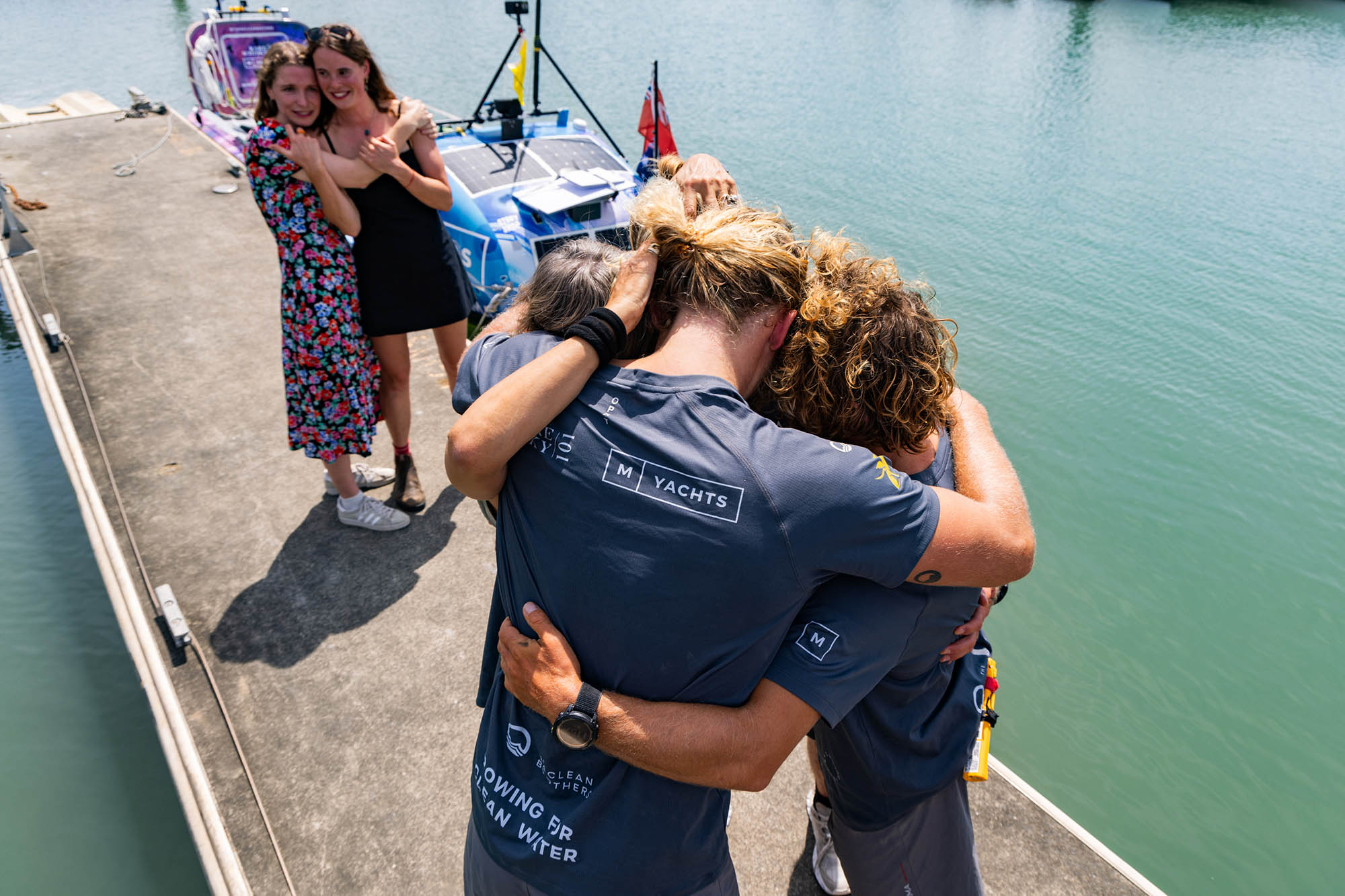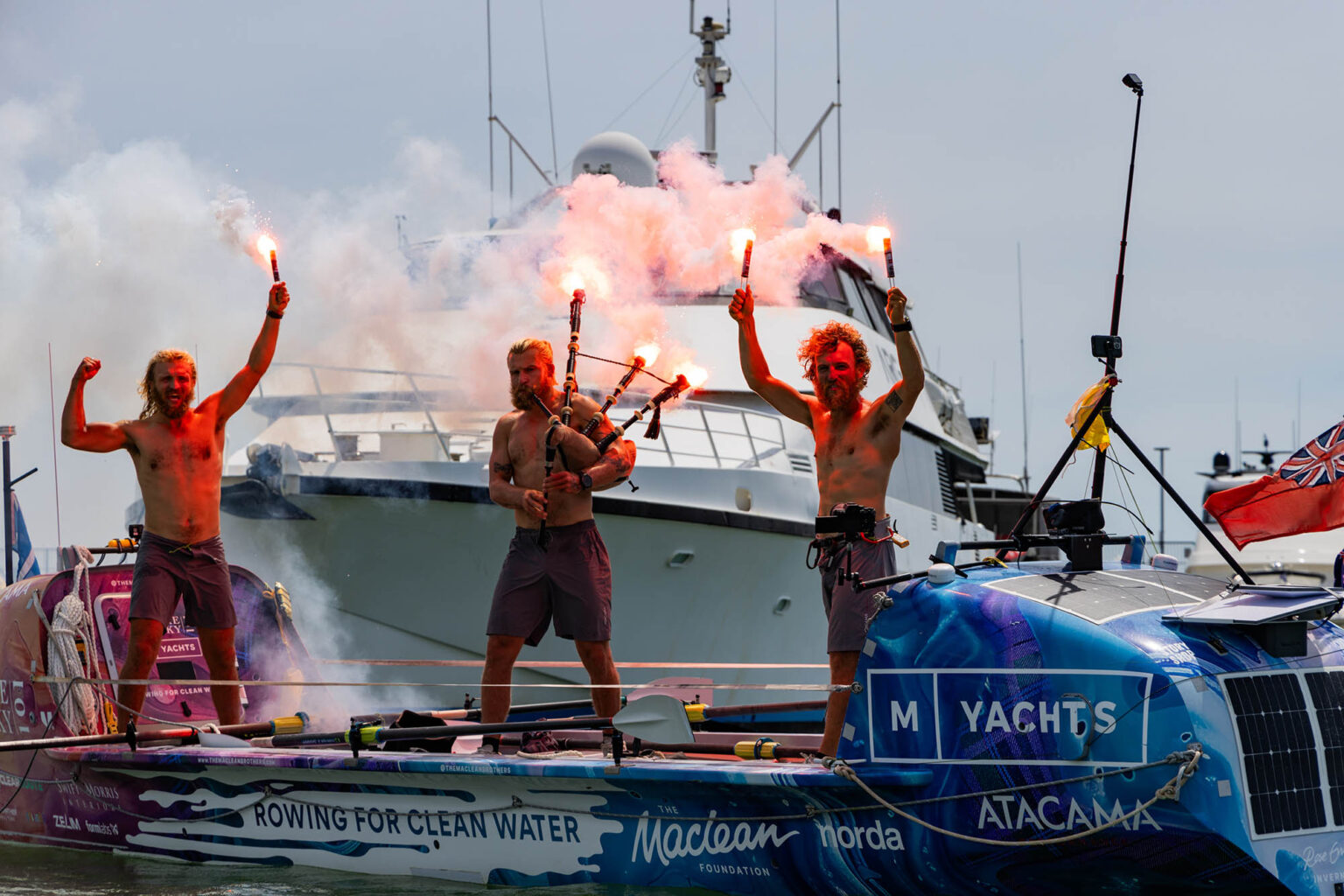Three brothers from Scotland set a world record Saturday, August 30, completing the fastest unsupported row across the Pacific Ocean.
Ewan, 33, Jamie, 31, and Lachlan Maclean, 27, completed the 9,000-mile journey in 139 days, arriving in Cairns, Australia. They started their journey in Peru, becoming the first team to achieve the full crossing from South America to Australia.
The trio from Edinburgh endured seasickness, injuries, and violent storms, including one that swept Lachlan overboard. The team also raised over $945,690 for clean water projects during their journey, frequently posting videos on social media.
By the end of it all, they’d shaved 21 days off the previous record, set by Russian solo rower Fyodor Konyukhov in 2014.
A week after ending their journey, Lachlan Maclean took some time to answer a few GearJunkie questions through voice notes. The following interview has been edited for clarity.
GearJunkie: What was your training and preparation going into this?
Lachlan Maclean: We were lucky enough to work with a woman, Chloe Lanthier, for about 15 months to prepare physically and mentally for this trip. Chloe is a world expert in biomechanics, sports physiology, and human performance.
She’s also an athlete herself, and she’s done some big expeditions in Alaska on mountain enduro bikes. She works with Rafael Nadal and Paris Saint-Germain, and she does lots of work with NASA, so she’s really top of her game.
We were working with her for over a year leading up to the row, and it was a mixture. Lots of, obviously, high volume on rowing machines and actually on the water, in the boat — lots of rowing every day … at least six days a week.
And then that was balanced with a gym-based program, which was lots of mobility, dynamic exercises, [and] core. It was very, very holistic: everything from finger exercises to get our grip strength and our wrists healthy, all the way to our ankles, and our toes, and our feet.
So it was really full body and quite intense, probably on average about 3 hours a day in the months leading up to it … I think the biggest week we had was about 45 hours of training in one week.
Was there something from that training that really paid off once you had started the attempt?
Yeah, I think that it was probably the holistic nature of the program. Chloe is just such an amazing person to work with because she has such an understanding of the human body — not just as a scientist, but also as an athlete.
She gave us very specific exercises to correct imbalances. For example, I didn’t have full range of motion in my right hip. She worked hard to align us. It’s all very well to have loads of power in your legs and your glutes, and have a powerful stroke.
But if your wrists and your shoulders aren’t going to be able to row, you’re going to get tendinopathy in your wrists after 6 to 8 weeks at sea. Then you’re not going to be able to row.
Probably one of the biggest surprises was, she had a goal to change our metabolism. She kept saying that we were going to finish this row [without losing] lots of weight because we were going to eat well.
All the work we did in the lead-up was changing our metabolism, so we would be more efficient, be able to sustain a higher output with less fuel … So quite staggeringly, none of us lost even half a kilo in 139 days at sea.
Jamie and I put on 3.5 kilos of muscle mass [nearly 8 pounds], which, yeah, big surprise to us. We felt really good by the end of it, and Chloe — her program just worked, and she evidently did change our metabolism. Yeah, quite an amazing woman.
Other rowing teams in this race often speak about the importance of teamwork, and helping one another through their worst moments. What was that experience like for you?
One hundred percent. I think that if we were to pinpoint one superpower between the three of us, it is the fact that we’re brothers, and I think we have really good teamwork. We’ve all got strengths and weaknesses, and I think that it’s like creating something that’s greater than the sum of its parts … We compensate for each other’s weaknesses, and therefore we’re able to do these big trips and work together towards a kind of shared goal.
And we’re doing it for the same reasons. Our primary objective has been to try and raise a million pounds [$1.3 million for clean water projects], and also to do it as safely and as fast as we possibly can. If one of us was trying to do it for purely performance reasons, one of us was doing it for fundraising reasons, and one of us was doing it for fun … that could lead to some disagreements over decision-making.
From Anti-Cyclones Back to Fundraising
Was there a specific moment that showed your ability to work together?
I would say one of the most dramatic moments was about two-thirds of the way through. We got hit by an anti-cyclone, so it’s a cyclone that’s traveling in an anti-clockwise direction … I was swept overboard. We’d had two knockdowns that day, when you get a side-on wave: the boat gets hit side on, and it kind of goes to 90 degrees.
I was about to get into the cabin. I was looking at these big conditions, 20- to 30-foot waves … There was this rogue wave, came in from about 90 degrees to the boat, and a big wall of water crashed right over the boat and took me with it. So I got swept over the starboard side — I thought that the boat was capsizing.
I wasn’t really sure what was happening, to be honest. Then the next moment I’m in the water. It’s dark, I don’t know which way is up, which way is down … suddenly, I’m looking at the back of the boat.
Ewan saw this happen. He reacted really fast, got to the stern of the boat, didn’t think twice — just reacted within a couple of seconds, really. And then he managed to reach over and give me a hand and got me back on board. I think it was a scary moment for both of us.
Part of our preparation was we did lots of exposing ourselves to the things we were scared of, like being in the water at night, doing sleep-deprived training … I think our preparation really helped in that scenario.
How much funding did you raise for your foundation through this race? And do you already have plans for future events, for raising additional money for charity projects?
We’re at about 920,000 pounds [$1.2 million] for clean water projects. So we’re very, very close to the target, but we’re not there yet. That money will give 40,000 people clean water for life in Madagascar. If we can hit the million — that’s really been the north star of this whole project. It’s got us across that ocean, and kept us motivated.
We do have plans for future events for raising additional money. We’re gonna keep plugging away until we get to the million. We’ve had lots of interviews, and we’ll be continuing to work hard until we hit that target. It’s very important to us.
In terms of rowing-related stuff, we will be bringing the boat back to Scotland over the next few months. She’s getting shipped back and then we’ll be keen to get the boat up to the northwest of Scotland, which is where Jamie and I are based.
There’ll be some more rowing in the future, but no big trips at the moment. I think we’re very conscious of loved ones, in particular our girlfriends. We’ll need to stay on land for a little bit before setting off on another trip, having just been away for 6 months.

What were you most excited to do/eat/drink when you got back to shore?
I would say fresh fruit, pizza, beer — all of those things have been pretty phenomenal. A bed and a shower has been really nice. Funny enough, the first 4 or 5 days, I struggled to sleep. I was waking up quite a lot just because my circadian rhythm is probably a bit out of kilter.
The biggest thing has been seeing loved ones, seeing my girlfriend Haida, and seeing Mom and the friends and family who came out to see us in Cairns. It kind of feels like being reborn in a sense. You just appreciate everything way more after a trip like this.
Whether it’s the softness of a bed or even colors, plants, green foliage, or a nice coffee — everything feels amazing. It’s not really a specific thing. It’s felt like being reborn and experiencing stuff for the first time again.

What did you gain from this experience?
If I were to mention one thing, I would say it’s just been unbelievable the number of people that got behind the project. I think there are about 13,000 people who have donated now. You see the best in people. A number of people have not just donated, but also done things to help us … We’ve had a 103-year-old knitting mittens. We’ve had people doing 24-hour rows on row machines. We’ve had people baking cakes, people running a mile a day.
We’ve had all sorts of things and it has blown us away. Sort of a mantra that we’ve come to towards the end of this trip is, “Helping yourself by helping others.”
This trip has obviously been very challenging for us, but we’ve also gained a huge amount from it.
Was it any different from what you expected?
It was probably more challenging than we expected, particularly the second half. The first two-thirds of the trip, we had pretty good weather.
Then the last third, we had lots of setbacks. We had storms. We had about 20 days on anchor, either sea anchor or on anchor and chain — we were hiding from a cyclone we got caught up in … We thought we were going to be done a lot sooner than we were. I think it was very challenging and particularly mentally challenging in that last little bit.
Anything else you’d like to add for our readers?
The only thing to add is that we are about 92% of the way towards our million-pound target. So if people would like to support us, to get to that target, we would really, really appreciate it.
We’re going to keep working as hard as we can until we get to it because it’s going to be 40,000 people with Clean Water for Life. It’s an entire municipality in Madagascar we’re trying to give clean water to. It’s a place we know well — we’ve been there multiple times.
The difference it will make is quite difficult to get your head around. Cheers.
As of this writing, the Maclean Brothers have raised 923,000 pounds — nearly reaching their goal of 1 million pounds for clean water projects in Madagascar. Visit their GiveStar page to donate.
Read the full article here





